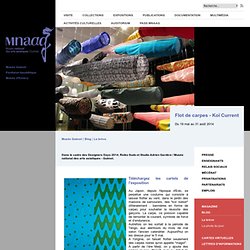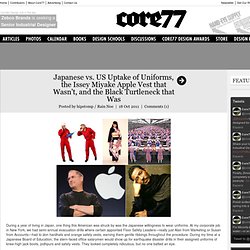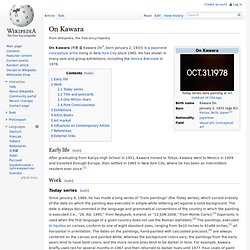

Flot de carpes - Koï Current. Dans le cadre des Designers Days 2014.

Reiko Sudo et Studio Adrien Gardère / Musée national des arts asiatiques - Guimet. Téléchargez les cartels de l'exposition Au Japon, depuis l'époque d'Edo, se perpétue une coutume qui consiste à laisser flotter au vent, dans le jardin des maisons de samouraïs, des "koï nobori" (littéralement : bannières en forme de carpe) pour souhaiter la réussite des garçons. La carpe, ce poisson capable de remonter le courant, symbole de force et d’endurance.Autrefois on les sortait à la période de Tango, aux alentours du mois de mai selon l'ancien calendrier.
Aujourd'hui on les dresse pour le 5 mai.A l'origine, on faisait flotter seulement des carpes noires qu'on appelle "magoï". www.inamori-f.or.jp/laureates/k22_c_issey/img/lct_e.pdf. Se réfugier dans la beauté. Photographies Ma Récréation.

La cérémonie du thé au Pavillon Miwa (cet événement n’est réservé qu’aux membres du club) Que c’est long d’être triste. Un solstice de chagrin qui se remet en boucle chaque matin. Depuis que je suis endeuillée, je me réfugie dans la beauté. Pas celle des produits dont je parle habituellement. Regardez les mains d’Emiko. Lundi, je m’absente pour plusieurs semaines de repos bien mérité.
Photographies Ma Récréation. L’Origata et Pavillon. L’Origata prend racine dans le Japon de l’ère Muromachi, au 14ème siècle.

C’est à cette époque que la famille Ogasawara théorisa l’art de l’Origata dans un manuel de protocole. Aujourd’hui, l’héritière du clan Ogasawara*, Keishosai Ogasawara, assure la direction de l’Origata au sein de Miwa. Quatre éléments forment la base de l’Origata : Le type de papier, appelé Danshi, traditionnellement papier d’origine biologique fait à la main et produit à partir des troncs d’arbres, qui sert à produire les feuilles utilisées ainsi qu’une fois torsadé très finement, les cordelettes nécessaires à l’emballage.
Suminagashi (japanese marbling) How to Make Edible Rice Paper. Rice paper is made from rice flour or rice straw.

Countries in south-east Asia use rice paper for a variety of purposes, and it has its use in art and craft (lampshades, cigarette paper) and even used in Thai, Korean, Vietnamese, and Chinese cooking. The methods of making rice paper that is used in cooking vary from the one used in craft. The edible rice paper is derived from rice flour, whereas rice straw is used to make the other kind of rice paper.
Making Edible Rice Paper Items Required A cup of rice flourWaterA large stockpotA bowlRolling pinQuilting hoopCheeseclothCooling RackMethodAdd the rice flour to the bowl. Uses of Edible Rice Paper Edible rice paper can be used to make various types of cakes and rolls which can either be stuffed with spicy and sweet fillings and baked, steamed, or fried. Now that you have basic idea about rice papers, how about preparing some spring rolls that can serve as a delicious appetizer?
Issey Miyake's A-POC. MIYAKE DESIGN STUDIO official site. Www.isseymiyake.com/en/brands/issey_miyake.html The ISSEY MIYAKE Collection is founded in the philosophy of clothing made from “a Piece of Cloth,” a concept which explores not only the relationship between the body and clothing, but also the space that is born between them.

The philosophy has evolved and grown as have Miyake’s interests always founded in innovative clothing combined with modern research and development. Japanese vs. US Uptake of Uniforms, the Issey Miyake Apple Vest that Wasn't, and the Black Turtleneck that Was. During a year of living in Japan, one thing this American was struck by was the Japanese willingness to wear uniforms.

At my corporate job in New York, we had semi-annual evacuation drills where certain appointed Floor Safety Leaders—really just Alan from Marketing or Susan from Accounts—had to don hardhats and orange safety vests, earning them gentle ribbings throughout the procedure. During my time at a Japanese Board of Education, the stern-faced office salarymen would show up for earthquake disaster drills in their assigned uniforms of knee-high jack boots, jodhpurs and safety vests. They looked completely ridiculous, but no one batted an eye. If an American walks into a 7-11 wearing a colonial-period uniform, you'd assume there was a Revolutionary War enactment going on nearby. Steve Jobs' black turtleneck reportedly explained in biography. On Kawara. On Kawara (河原 温, Kawara On?

, born January 2, 1933) is a Japanese conceptual artist living in New York City since 1965. He has shown in many solo and group exhibitions, including the Venice Biennale in 1976. Early life[edit] After graduating from Kariya High School in 1951, Kawara moved to Tokyo. Kawara went to Mexico in 1959 and travelled through Europe, then settled in 1965 in New York City, where he has been an intermittent resident ever since.[2] Work[edit] Today series[edit] Each Date Painting is registered in a journal and marked on a One Hundred Years Calendar. Title and postcards[edit] Much like the Today series, Kawara uses the number of days followed by the date the work was executed as his life-dates. One Million Years[edit] One Million Years is one of the artist’s best-known works about the passage and marking of time. On Kawara: I GOT UP; On Kawara (2001.228a-pp)